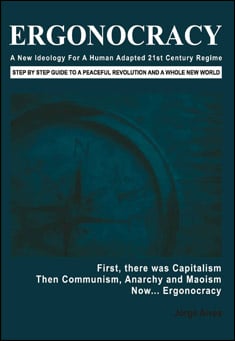Ergonocracy intends to provide an answer, a guide to a new regime.
Therefore, the target readership for this book will be all those who are desperately ready for change. It focuses on the following goals:
o To promote a system where there is an effective reduction of centralized power with the help of information technology, which will enable citizens to participate in the decision-making process;
o To abolish power intermediaries;
o To provide all citizens with equal political intervention power;
o To maximize individual freedom;
o To reform the capitalist system by eliminating the economic exploitation of man by man without questioning the freedom of private initiative;
o To create an economic system that will naturally lead to well-balanced prosperity, with the enhancement of human performance without excluding anyone in the process;
o To create one single class of workers who are simultaneously private company owners;
o To create an environment that facilitates an individual's integration into the system;
o To create a more efficient and expeditious judicial system;
The fundamental goal of these models is to present an innovative alternative form of public organization that is better adapted to the genuine nature of human beings.
The name - Ergonocracy - was chosen to highlight the importance of adapting man's surroundings to harmonize with his true characteristics, as is also the case with the term "Ergonomics ", which reflects a concern for the optimization of man's well-being and overall system performance in terms of his work environment.
Moreover, people cannot be blamed for wondering why our powerful modern information technologies are not utilized to improve democracy. Ergonocracy also provides an answer to this question.
Politically, Ergonocracy presents an original system of direct democracy with a political model in which citizens who are able to vote on legislation directly via an electronic platform, called a Community Web portal, exercise legislative power. Executive power is divided into pre-determined public functions and carried out by service companies called Concessionary Companies, by way of public tender.
Economically, this model's main purpose is to prevent the exploitation of Man by Man. This implies that the current concept of employers and employees will cease to exist. There will be a member-colleague business relationship, although certain partners may still have more influence in the organization. This model attempts to create the best of two worlds, the freedoms and advantages of private initiative on one hand, and the elimination of human exploitation on the other.
In social terms, each citizen can choose to live in any Local Community of Common Interest, which will allow the agglomeration of people with common interests and similar ways of life. It will be possible to set a desired profile for new neighbors. These selected criteria will have to be chosen by an overall majority of citizens. The Local Communities of Common Interest Model has the advantage of easing restrictions, facilitating the choices of common public common and helping to create an environment that allows for the integration of the citizen into the community.




